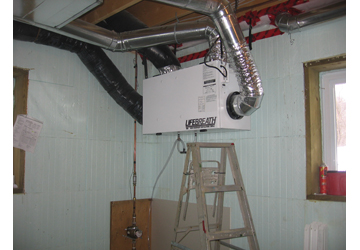Heat Recovery Ventilator - (HRV)
This is a listing page for heat recovery ventilation - HRV Contractors in your area.
Scroll down to visit HRV installer technicians in your area.
Heat recovery ventilation systems - HRV systems
Heat recovery ventilation systems work by extracting heat in the form of warm moist air from your home and redistributing to selected locations throughout your home. However, this heat must first pass through a heat exchanger in the heat recovery ventilator. The heat recovery ventilation systems extracts cold air from the outside. The cold air is then warmed by the collected warm moist air, from selected areas in your home, and passed through a heat exchanger. The fresh warm air is then distributed to the various rooms throughout the house. Filters are used to ensure high air quality. Although heat recovery ventilators can be placed in older homes it is preferable to install at the construction stage.

Heat Recovery Ventilator
The Heat recovery ventilation systems consists mainly of the heat recovery ventilator unit and service air ducting. One of the major challenges facing installers is to install it as a retrofit. The problem lies with the amount of air ducting needed. The air ducting used for HRV is extensive with a fairly broad diameter. Special housing units may have to be constructed in the various rooms for aesthetic reasons. Installing HRV systems in new-builds is far easier. The architect can incorporate the entire system in his design plan drawings.
Saving money on heating bills
Heat recovery ventilation systems are an excellent way of saving money on heating bills. In order to maximise the benefits of the HRV system your home should have a good air tightness value and be well insulated.
Carbon Footprint
HRV is an excellent way to reduce localised Carbon Footprint. Having your own Solar PV or Wind Turbine can make even greater CO2 emission savings. For further information on the topic of carbon footprint and HRV browse the Carbon Trust website. Carbon Trust is an independent body with worldwide interests.
Advantages:
- Cold air infiltration is kept to an absolute minimum.
- Savings on your heating bills.
- Reduced carbon footprint.
- The incoming cold air is filtered.
- Special pollen filters can be adopted for allergy sufferers.
- Ideal for asthmatics.
Disadvantages:
- Initial installation costs are quite high.
- Ducting can be visible in some room areas for retrofit installations.




